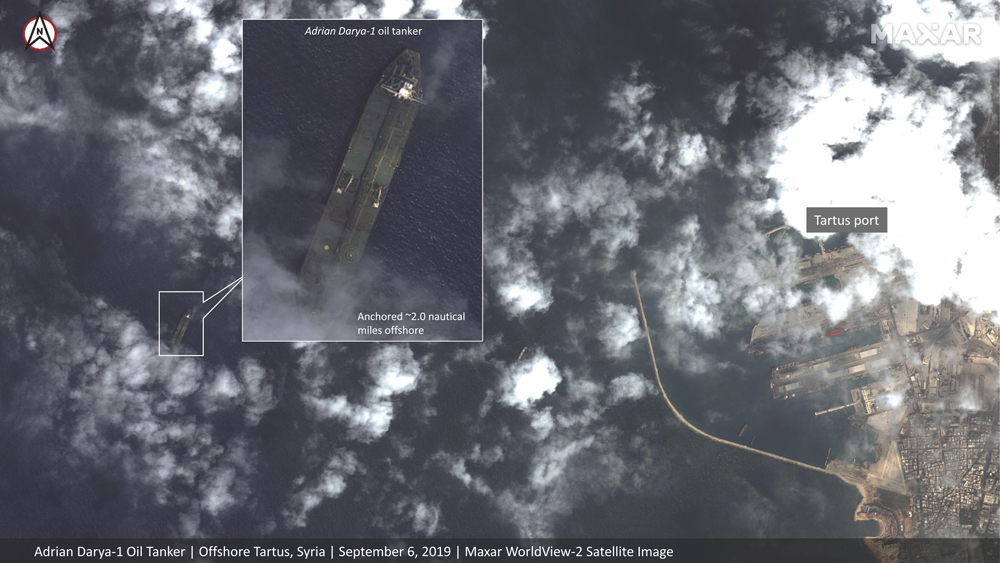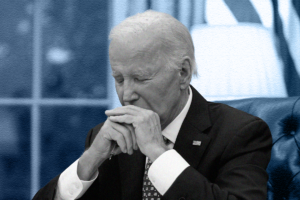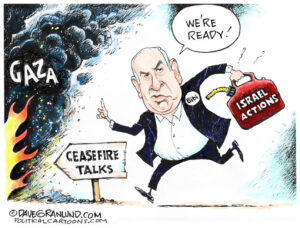Iran Raises Nuclear Stakes, Threatens Higher Enrichment
The nation now uses arrays of advanced centrifuges prohibited by its 2015 nuclear deal and can enrich uranium to weapons-grade material. A satellite image appears to show the oil tanker Adrian Darya-1 off the coast of Tartus, Syria, on Friday. U.S. authorities say the vessel is owned by Iran's Revolutionary Guard.(©2019 Maxar Technologies via AP)
A satellite image appears to show the oil tanker Adrian Darya-1 off the coast of Tartus, Syria, on Friday. U.S. authorities say the vessel is owned by Iran's Revolutionary Guard.(©2019 Maxar Technologies via AP)
TEHRAN, Iran—Iran on Saturday said it now uses arrays of advanced centrifuges prohibited by its 2015 nuclear deal and can enrich uranium “much more beyond” current levels to weapons-grade material, taking a third step away from the accord while warning Europe has little time to offer it new terms.
While insisting Iran doesn’t seek a nuclear weapon, the comments by Behrouz Kamalvandi of the Atomic Energy Organization of Iran threatened pushing uranium enrichment far beyond levels ever reached in the country. Prior to the atomic deal, Iran only reached up to 20%, which itself still is only a short technical step away from weapons-grade levels of 90%.
The move threatened to push tensions between Iran and the U.S. even higher more than a year after President Donald Trump unilaterally withdrew America from the nuclear deal and imposed sanctions now crushing Iran’s economy. Mysterious attacks on oil tankers near the Strait of Hormuz, Iran shooting down a U.S. military surveillance drone and other incidents across the wider Middle East followed Trump’s decision.
“So far, Iran has showed patience before the U.S. pressures and Europeans’ indifference,” said Qassem Babaei, a 33-year-old electrician in Tehran. “Now they should wait and see how Iran achieves its goals.”
Iran separately acknowledged Saturday it had seized another ship and detained 12 Filipino crewmembers, while satellite images suggested an Iranian oil tanker once held by Gibraltar was now off the coast of Syria despite Tehran promising its oil wouldn’t go there.
Speaking to journalists while flanked by advanced centrifuges, Kamalvandi said Iran has begun using an array of 20 IR-6 centrifuges and another 20 of IR-4 centrifuges. An IR-6 can produce enriched uranium 10 times as fast as an IR-1, Iranian officials say, while an IR-4 produces five times as fast.
The nuclear deal limited Iran to using only 5,060 first-generation IR-1 centrifuges to enrich uranium by rapidly spinning uranium hexafluoride gas. By starting up these advanced centrifuges, Iran further cuts into the one year that experts estimate Tehran would need to have enough material for building a nuclear weapon if it chose to pursue one.
“Under current circumstances, the Islamic Republic of Iran is capable of increasing its enriched uranium stockpile as well as its enrichment levels and that is not just limited to 20 percent,” Kamalvandi said. “We are capable inside the country to increase the enrichment much more beyond that.”
Iran plans to have two cascades, one with 164 advanced IR-2M centrifuges and another with 164 IR-5 centrifuges, running in two months as well, Kamalvandi said. A cascade is a group of centrifuges working together to more quickly enrich uranium.
Iran has already increased its enrichment up to 4.5%, above the 3.67% allowed under the deal, as well as gone beyond its 300-kilogram limit for low-enriched uranium.
While Kamalvandi stressed that “the Islamic Republic is not after the bomb,” he warned that Iran was running out of ways to stay in the accord.
“If Europeans want to make any decision, they should do it soon,” he said. France had floated a proposed $15 billion line of credit to allow Iran to sell its oil abroad despite U.S. sanctions. Another trade mechanism proposed by Europe called INSTEX also has faced difficulty.
Kamalvandi also said Iran would allow U.N. inspectors to continue to monitor sites in the country. A top official from the U.N.’s International Atomic Energy Agency was expected to meet with Iranian officials in Tehran on Sunday.
The IAEA said Saturday it was aware of Iran’s announcement and “agency inspectors are on the ground in Iran and they will report any relevant activities to IAEA headquarters in Vienna.” It did not elaborate.
In Paris, U.S. Defense Secretary Mark Esper said Iran’s announcement wasn’t a surprise.
“The Iranians are going to pursue what the Iranians have always intended to pursue,” Esper said at a news conference with his French counterpart, Florence Parly.
For his part, Trump has said he remains open for direct talks with Iran. A surprise visit by Iranian Foreign Minister Mohammad Javad Zarif to the Group of Seven summit in France last month raised the possibility of direct talks between Trump and Iranian President Hassan Rouhani, perhaps at this month’s United Nations General Assembly in New York, though officials in Tehran later seemed to dismiss the idea.
Meanwhile Saturday, Iranian state TV said the tugboat and its 12 crewmembers were seized on suspicion of smuggling diesel fuel near the Strait of Hormuz. The report did not elaborate. In Manila, the Philippines’ Department of Foreign Affairs said it was checking details of the reported seizure.
Also Saturday, satellite images showed a once-detained Iranian oil tanker pursued by the U.S. appears to be off the coast of Syria, where Tehran reportedly promised the vessel would not go when authorities in Gibraltar agreed to release it several weeks ago.
Images obtained by The Associated Press from Maxar Technologies appeared to show the Adrian Darya-1, formerly known as the Grace-1, some 2 nautical miles (3.7 kilometers) off Syria’s coast.
Iranian and Syrian officials have not acknowledged the vessel’s presence there. Authorities in Tehran earlier said the 2.1 million barrels of crude oil onboard had been sold to an unnamed buyer. That oil is worth about $130 million on the global market, but it remains unclear who would buy the oil as they’d face the threat of U.S. sanctions.
The new images matched a black-and-white image earlier tweeted by John Bolton, the U.S. national security adviser.
“Anyone who said the Adrian Darya-1 wasn’t headed to #Syria is in denial,” Bolton tweeted. “We can talk, but #Iran’s not getting any sanctions relief until it stops lying and spreading terror!”
U.S. prosecutors in federal court allege the Adrian Darya’s owner is Iran’s Revolutionary Guard, which answers only to Supreme Leader Ayatollah Ali Khamenei. On Wednesday, the U.S. imposed new sanctions on an oil shipping network it alleged had ties to the Guard and offered up to $15 million for anyone with information that disrupts its paramilitary operations.
___
Gambrell reported from Dubai, United Arab Emirates. Associated Press writers Robert Burns in Paris, David Rising in Berlin and Jim Gomez in Manila, Philippines, contributed to this report.
Your support matters…Independent journalism is under threat and overshadowed by heavily funded mainstream media.
You can help level the playing field. Become a member.
Your tax-deductible contribution keeps us digging beneath the headlines to give you thought-provoking, investigative reporting and analysis that unearths what's really happening- without compromise.
Give today to support our courageous, independent journalists.








You need to be a supporter to comment.
There are currently no responses to this article.
Be the first to respond.